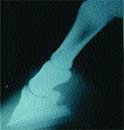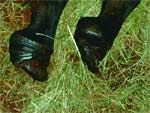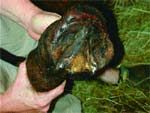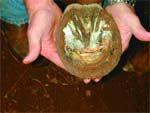Successful laminitis rehab must involve client
Pastures that were dry and thin last year are now lush and green, thanks to a generally wet spring this year.
Pastures that were dry and thin last year are now lush and green, thanks to a generally wet spring this year.

Many horses in differing areas of the country are experiencing lush green pastures this year as a result of increased spring and early summer rains. Overeating green grass remains one of the leading causes of founder and practitioners should be encouraging horse owners to monitor their horses' body weight and condition even if "that horse has been in that pasture for years without a problem."
The increased grass has been beneficial to an extent, but it has also increased the number of laminitis cases seen this year. While there are many causes of laminitis, overeating on lush green grass remains one of the most common initiating events.
Equine practitioners are constantly receiving new information and research updates about this potentially devastating disease. Papers presented at the 2003 Equine Laminitis Symposium in January at the University of Wisconsin School of Veterinary Medicine reviewed the pathophysiology and biomechanical factors leading to the development of founder. It also explored contributing conditions such as SIRS (systemic inflammatory response syndrome), MODS (multiple organ dysfunction syndrome) and CARS (compensatory anti-inflammatory response syndrome).
Various shoeing options for the laminitic horse were discussed, including stacked wedge pads, reverse shoes with or without pads, heart-bar shoes, egg bars, rockered toe shoes, pour-in acrylic materials and rail shoes.
Sometimes, it is difficult to remember that in the midst of all these high-tech shoeing options and the alphabet soup of potential causative syndromes is a horse owner and a diseased animal. All too often clients receive up-to-the-minute information on the molecular causes of laminitis and informative discussions on rotation angles and break-over points and yet are not given the simple information and helpful tips necessary to care for these horses during their recovery.
Don't forget horse

Radiography is very important both to the immediate diagnosis and prognosis in cases of laminitis, and also to the long-term management and maintenance of these horses.This lateral view shows a chronic founder case that is not being trimmed aggressively enough. Re-alignment of the dorsal hoof wall and the bottom surface of PIII are very important and this horse, because of an excessively long toe, is actually damaging crucial new laminar growth.
Let's take a look at the management of the laminitic horse and focus on the practical points that every veterinarian should know since these are the problems (and solutions) that the client will discuss. This everyday founder management and nursing care may actually have more to do with the successful outcome of a case of laminitis than will an understanding of the correct physiology, special shoes or any medication.
The first thing that owners must recognize is that all laminitis cases are different. What works for one horse may or may not work for another. Treatment for laminitis is a long-term process and changes in care and management will be made accordingly.
The client will, of necessity, have to be an integral part of the rehabilitation team. The client's input, observations and concerns should be treated with importance. These people will be the ones spending the most time with these horses and they will usually have the best information as to how that horse is progressing.
Teamwork critical
Many clients have related that they were not adequately prepared for the length of the healing process or for the labor demands of simply caring for these horses. For example, Vickie Butler, whose horse, Hollywood, recently survived a severe case of laminitis from exposure to poisoned deer feed, felt that the medical treatment she received at a veterinary school was excellent but that the support and rehabilitation guidance she received upon taking her horse home was deficient.

This horse is lying down in a peat moss bedding stall, but she spends a substantial portion of her day standing up. Severe laminitis and dorsal wall separation caused total detachment of the dorsal hoof wall and the hoof capsule literally slid off the foot. Substantial new growth can be seen at the coronet and, with time and attentive nursing care, an entirely new hoof capsule will grow.
"At times all I really needed was to be told that things were progressing normally and that our progress, however slow, was OK," Butler says. "But they (doctors at the veterinary school) did not seem to understand that. Once the initial phase was over and I brought my horse home for what became a long rehab, I felt like I was on my own."
Continual repeated monitoring of these cases is important. As a result, some practices have developed laminitis "support groups" for their clients. These groups can simply be a list of phone numbers for clients who have already dealt with a case of extreme founder. They know the ups and downs of these cases and are usually well equipped to lend a sympathetic ear on a day when the foot abscesses have returned and the horse is not doing well. They can be an experienced viewpoint when an owner begins to wonder if continuing to try with a particular horse is the correct response.
This is, in fact, the most commonly asked question: "Should I stop his/her suffering or keep going in hopes that my horse will improve?" Veterinarians need to realize that almost all owners of horses suffering from severe cases of laminitis tend to have these concerns at some point in the rehabilitation process.

This view shows the dorsal laminar separation from the sole surface. Most of the drainage in the foot occurs here and packing with Epsom salt paste, iodine based paste or other substances designed to help draw out the serum and abscess fluid, and providing a support bandage are the best steps to help encourage healing.
Positive reinforcement, when justified, may be all the client needs to continue cleaning and bandaging, rolling and flushing, and may eventually lead to that horse's successful healing. Telling a client his or her horse is not progressing and should be considered for euthanasia can also be the correct course of action, but the veterinarian must be very certain that this is the best decision for the horse and for the owner.
You can do it!
It is recommended that severe laminitis cases be managed in 10-day blocks. The situation is given 10 days and then re-evaluated. Based on this new examination, the decision is made to go forward for another 10 days or to consider a different approach, which may include euthanasia.
Many horses in the initial stages of laminitis spend considerable time lying down in their stalls. This should be encouraged since this position takes pressure off the deep digital flexor tendon which, when the horse is standing, tends to pull against PIII and can actually worsen the rotation.
However, lying down in the stall can lead to decubitus ulcers. These raw, irritated patches are caused by the abrasive nature of straw or shavings. The use of peat moss for stall bedding will greatly reduce these ulcers and the clean absorptive nature of the peat will also help drain foot abscesses.
Avoiding ulcers
Peat moss can be obtained from any garden supply store. A new company has introduced a packaged peat specifically for horse stalls, as this product is cleaner and finer screened to reduce dust. Four to six, 6-cubic foot bags will be enough for a standard 12 by 12 stall and will last about a month. The peat can be sprayed with water periodically to minimize dust and the manure is removed as usual. Urine is absorbed by the peat, so no urine smell is detectable. Used peat can be discarded in gardens or used as mulch.
Horses that spend most of their time down must be rolled frequently and should be encouraged to stay in sternal recumbency as much as possible. Many horses will learn to allow owners to clean and wrap their feet while lying down.
Foot care in the early stages of laminitis is crucial. Dr. Steve O'Grady, veterinarian and master farrier, urges veterinarians to resist the urge to put shoes on the horses until they are ready. "Sometimes the best founder shoe," O'Grady says, "is no shoe at all."
To shoe or not
He favors steps to make the horse comfortable and to allow the initial inflammatory stage of founder to subside. Once the horse is stable, wide web aluminum or rail shoes with acrylic packing materials are his favorite approach, though O'Grady echoes the statement that no two laminitis cases are the same.
Prior to shoeing, the feet can be wrapped with diapers and vet-wrap or similar combinations to provide absorptive support for the hooves. Frog support can be provided with Lily pads, gauze rolls that are folded over and duct-taped into small pads, or other similar setups.
Most laminitis cases will show some degree of dorsal wall separation as solar abscesses in the region of the toe. Initially clients should be encouraged to drain these abscesses. Packing materials such as Magnapaste (Epsom salts), ichthymol, or Betadine and sugar can be used. The packing material is applied and the horse's hoof is wrapped with tape and bandage material. Often the abscesses will need to be opened to facilitate drainage.
There are no specific recommendations for shoeing the foundered horse, because there are too many variables between cases. However, O'Grady sees the basic principles as correcting or realigning the dorsal hoof wall and the dorsal surface of PIII, correcting the solar hoof margins, raising the heels if decreased pressure on the deep digital flexor is needed and removing pressure on the dorsal hoof wall. Many shoes will eventually be used as the foot changes and the laminitis resolves. Dr. Robert Hunt, speaking at the 2003 Equine Laminitis Symposium, says, however, "No single shoe is suitable for all situations."
Each case unique

The vast majority of horses will exhibit a solar surface that looks like this. Practitioners sometimes confuse the appearance of the solar lamella tissues with a penetration of the sole by PIII. This horse was packed and wrapped, and eventually regrew a new sole and returned to soundness.
Occasionally owners and veterinarians will see a horse that starts to slough off its hoof capsule or starts to drain on the sole surface in front of the point of the frog. The sole separates and a section of clear to yellowish tissue can be seen deeper in the sole.
The general comment is that these horses are rotating PIII through the bottom of the foot and that these horses will be lucky to survive. In fact, the majority of these cases are simply inflammations of the solar laminae that are open and draining and many of these laminitic cases show little if any rotation. Packing and wrapping these feet will help resolve drainage and a new sole will re-grow to replace the damaged one. In this stage of rehabilitation owners may need encouragement because this stage lasts for a while and improvements are very hard to notice.
Foundered horses should be kept slightly thinner than usual because additional weight can increase the forces on the deep digital flexor tendon. Conversely, these horses must now regrow new hoof capsules and will need a significant protein source for this task. Quality low protein feed with plenty of hay or pasture is usually sufficient.
Pain relief, reduction of inflammation and improved vascular support of the hoof are the main reasons medical therapy is used with foundered horses. Many drugs can be debated as to their exact modes of action and effectiveness in the laminitic horse. General principles are to make the horse comfortable and to use the least amount of medication necessary. Newer drugs are continually being introduced with claims to aid in founder cases. They will have to be tested and evaluated before their use can be encouraged.
Limit medication
Overall, it often seems that once the clinician has applied all the medical information and results of new studies, he or she is still left with a horse with very sore feet. The client quickly becomes the principal caregiver and the veterinarian, once the horse is stabilized enough to return to a semi-normal routine, must be supportive to the caregiver. Attention to small details like skin infections/irritations, diet and general well-being can have a significant effect on the eventual outcome of these cases.
Dr. Marcella, a 1983 graduate of Cornell University's veterinary college, was a professor of comparative medicine at the University of Virginia. His interests include muscle problems in sport horses, rehabilitation and other performance issues.